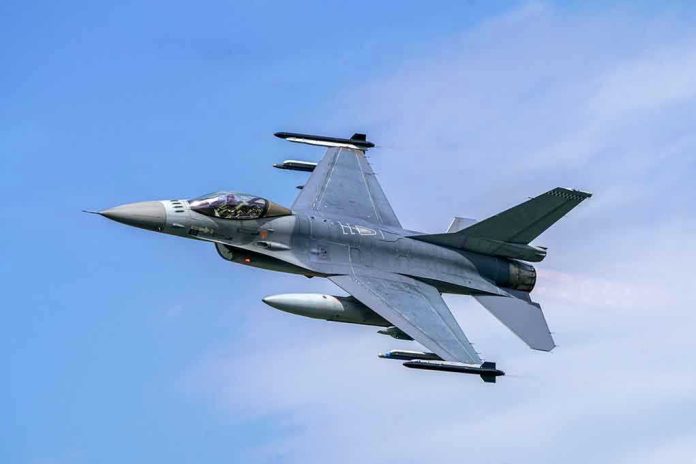
One split-second maneuver at the Dubai Air Show ignited a fireball that now threatens the future of India’s most ambitious fighter jet—and the reputation of its entire aerospace industry.
Story Snapshot
- An Indian Air Force pilot died in a fiery Tejas Mk.1 crash during a live Dubai Air Show demonstration.
- The incident raises hard questions about the safety and export prospects of India’s flagship indigenous fighter.
- Global audiences witnessed the crash, amplifying its impact on India’s defense image and future deals.
- Industry experts and defense officials are bracing for fallout as investigations begin and reputations hang in the balance.
Tejas Crash at Dubai: A Tragedy Unfolds Before the World
On November 21, 2025, the spectacle of the Dubai Air Show was violently interrupted as an Indian Air Force Tejas Mk.1 fighter jet plummeted from the sky and erupted in a fireball at Al Maktoum International Airport. Wing Commander Namansh Syal, piloting the aircraft during a high-stakes aerial display, became the tragic face of a disaster watched live by thousands and recorded for millions more. The moment was not only a blow to the pilot’s family and colleagues but also cast a shadow over India’s ambitious efforts to stake its claim in the global defense market with the Tejas program.
Spectators and media witnessed the jet’s rapid descent after a negative G-force maneuver, a notoriously risky feat at low altitude. Within seconds, the aircraft slammed into the ground, sending up black smoke and flames. Emergency crews rushed in, but the pilot’s life could not be saved. The incident became an instant headline, with footage circulating widely and sparking immediate international response.
India’s Indigenous Fighter Program Under Scrutiny
The Tejas, a single-engine, multirole combat aircraft, is the pride of Indian aviation, symbolizing decades of effort to replace the aging MiG-21 fleet and achieve technological self-reliance. Developed by Hindustan Aeronautics Limited (HAL), Tejas entered service in 2016 after a protracted journey marked by technical hurdles and delays. India has aggressively promoted the jet for export, with the Dubai Air Show serving as a critical showcase for international buyers. The crash, however, threatens to undermine years of hard-won credibility and recent export momentum.
This tragedy marks the second Tejas crash in less than two years. The first occurred in Rajasthan, India, in March 2024, where the pilot ejected safely. Until these incidents, Tejas had a strong safety record, which HAL and the Indian Air Force touted as a selling point to potential buyers. Now, the back-to-back accidents invite fresh scrutiny of the program’s operational integrity, technical reliability, and readiness for global deployment.
Emergency Response and Ongoing Investigation
Responding instantly, the Dubai Air Show organizers and United Arab Emirates Ministry of Defense secured the crash site and coordinated firefighting efforts. The Indian Air Force quickly confirmed Wing Commander Syal’s death and announced a court of inquiry to determine the cause of the accident. HAL issued public condolences and pledged support to the bereaved family, while defense officials emphasized their commitment to transparency and safety improvements.
The Dubai Air Show, while continuing its program, faces heightened safety protocols and greater attention to demonstration risk management. The global defense and aerospace community now watches closely as investigators analyze flight data, pilot actions, and aircraft systems to pinpoint what went wrong. The outcome will shape not only Tejas’s reputation but also broader perceptions of India’s ability to field reliable indigenous technology on the world stage.
Industry Fallout and the Future of Indian Defense Exports
In the immediate aftermath, industry analysts warn that the Tejas program faces both short-term embarrassment and long-term obstacles. The loss of an experienced pilot, combined with the spectacle of a public, fatal crash, disrupts ongoing export negotiations and may delay further demonstrations. HAL’s ambitions to secure lucrative international contracts could be complicated by heightened safety concerns and buyer wariness.
Defense commentators argue that such incidents, while tragic, are not uncommon in military aviation, especially during high-risk displays. Yet the timing and visibility of the Dubai crash—its proximity to recent deals and its massive audience—mean its impact may outstrip the technical facts. Buyers and partners may demand stricter safety assurances and more rigorous oversight, driving up costs and slowing momentum.
Expert Analysis: Maneuvers, Risk, and Program Reputation
Aviation experts highlight that negative-G maneuvers at low altitude, like the one preceding the crash, require extreme precision and leave little margin for error. Even for experienced pilots, these stunts can become deadly if conditions deviate. While Tejas’s overall safety record remains robust compared to many legacy jets, two crashes in two years create a statistical and psychological challenge for HAL and the Indian Air Force.
Industry voices urge a sober, transparent inquiry, not only to secure answers for the pilot’s family but also to reinforce confidence among existing and prospective buyers. The episode catalyzes debate about the risks inherent in flashy airshow demonstrations, the adequacy of pilot training, and the pressures of promoting indigenous technology in a fiercely competitive global market. As the investigation unfolds, the answers may determine whether Tejas can recover its standing—or if a single fireball will define its international legacy.












